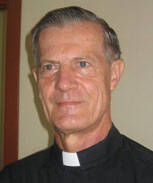Jesuit missionaries have been anthropologists, grammarians, astro-nomers and preservers of culture in Asia and the Americas. This is happening now in the Pacific through the Micronesian Seminar. Mic-Sem, as it is known, aims to serve the local people and preserve their heritage. In this case, “local” has a rather wide meaning; it covers islands spread across an area larger than the United States.
My opportunity to visit the Mic-Sem came after I was invited to direct an eight-day retreat last year for 20 Jesuits gathered on the island of Pohnpei. As a novice some 50 years earlier, I had volunteered for this mission of the New York Jesuit Province in the middle of the Pacific Ocean. I did eventually become a missionary—but on the other side of the globe, in Africa, for over 20 years. The retreat gave me an opportunity to expand my horizons and see the tremendous achievements of the Jesuits in Micronesia.
Mic-Sem and its staff of 10 are based in a modest two-story building close to the Pohnpei airport. Begun in 1972, it has been directed since then by my Jesuit friend Fran Hezel, originally from Buffalo, N.Y. His full name is Francis Xavier Hezel, and in many ways he carries on the endeavors of the saint with whose name he was baptized. While Xavier was a high-jumper at the University of Paris in the 16th century, Fran, who clocked 70 in January, continues to play half-court basketball almost every day. Even before he was ordained, he was assigned to Micronesia; and his entire Jesuit ministry has been with the people of Micronesia.
The purpose of Mic-Sem is “to stimulate reflections on current issues in the light of Gospel values.” The impact of the recent economic downturn upon the islands is the current hot topic. Fran explains that Mic-Sem “is a mixture of many things—and always new and growing.” The library is a cornerstone of the institution. With about 20,500 book titles, it is recognized worldwide as one of the best collections on Micronesia. While its special strengths lie in history and anthropology, it is rapidly expanding in related fields such as government, education, social and economic development, and the natural sciences.
Besides print materials, the library collection includes maps, microfilm, videos, transparencies and photographs on Micronesian history. The collection contains about 55,000 images, 14,000 tracks of local music and about 700 videos.
Mic-Sem has produced several books and many occasional bulletins (the latest is No. 75). The media studio has produced 63 videos on a wide variety of social issues. These are broadcast on local television stations and are available in VHS and DVD formats, as well as online.
Most of the library resources are also available on the Internet. A glance at the seminar’s Web site, www.micsem.org, will introduce you to the history and current situation in Micronesia in a variety of ways. Photo albums have became my favorite feature, with 30 albums on the history and culture of the islands. One powerful presentation, entitled “Nuclear Nomads,” describes the impact of atomic weapons tests near the islands from 1946 to 1958.
As one of the world’s experts on Micronesia, Fran looks back on his years of service and his contribution to the people of Micronesia and says modestly, “It has been a good ride.” He adds that the key to whatever success they have achieved is always to reflect with the people, not over or for them, “to examine how ordinary lives and traditional cultures are being changed, challenged by modernization and structural changes.” Although he is not slowing down on the basketball court or in his research, he admits he is looking to the time when he can hand on the leadership of Mic-Sem to a local layperson or a Micronesian Jesuit.








